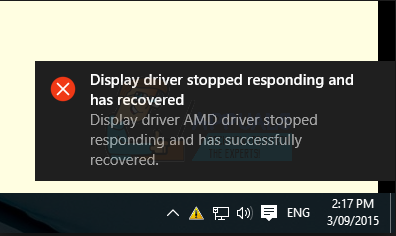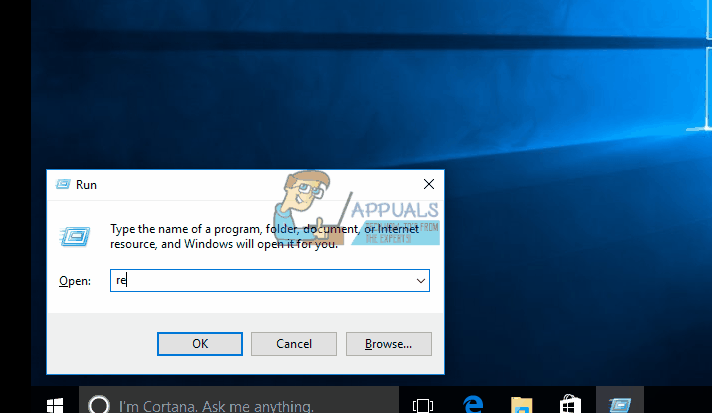Fix: Display Driver Stopped Responding and has Recovered
Sometimes, a Windows computer may become incredibly sluggish during use, which may be followed by the computer’s screen turning off and then back on. After this, an error message stating, ‘Display driver stopped responding and has recovered’ can typically be seen in the Notification Area, located in the bottom-right corner of the screen. This usually happens when a feature known as Timeout Detection and Recovery (TDR) determines that the GPU has not responded in the allotted period. In such instances, TDR restarts the display drivers, saving the user from having to restart the computer entirely.
Some of the most common causes of the “Display driver stopped responding and has recovered” error include excessive program activity straining the GPU, issues with the computer’s display drivers, and an overheating GPU. This issue affects all versions of the Windows operating system, from Windows XP to Windows 10. Occasional appearances of this error message are not a cause for alarm. However, if the message appears frequently, it may indicate a serious underlying issue.

Thankfully, though, the “Display driver stopped responding and has recovered” error message can be fixed as long as it is not caused by a defective GPU. If you want to solve this problem, the following are the most effective solutions that you should try:
Solution 1: Uninstall and then reinstall your graphics drivers
To launch a Run command, press the Windows Logo key + R.
Type devmgmt.msc into the Run dialog and press Enter to launch the Device Manager.
In the Device Manager, expand the Display adapters.
Right-click on your graphics drivers, click on Uninstall and then go through the uninstallation wizard to uninstall the drivers. If you have more than one graphics driver, do the same for every one of them.

First, restart your computer. It should automatically reinstall the same version of the graphics drivers upon booting up. If it doesn’t, visit the official website of your GPU manufacturer, find the drivers, download and install them manually. After reinstalling the drivers, check if the problem has been resolved.
Solution 2: Update your graphics drivers,
If a newer version of the graphics drivers for your computer is available, downloading and installing them may be able to fix this problem for you. To check for a newer version of your computer’s graphics drivers, log on to the official website of your GPU’s manufacturer, head over to the Downloads or Support section and see if a newer version is available for your specific GPU. If such a version is available, download and install it, then check to see if that resolves the issue.
Solution 3: Increase the TDR timeout for your GPU
TDR (Timeout Detection and Recovery) has a predetermined time period. At the end of this period, if a Windows computer’s GPU does not respond, the feature reboots the display drivers. At this juncture, the message ‘Display driver stopped responding and has recovered’ is displayed. If you frequently encounter this error message, it’s plausible that the set timeout for TDR is too short for your GPU to respond promptly. As a result, the display driver reboot is repeatedly triggered.
If this is the case, you can resolve this issue by simply increasing the TDR timeout for your GPU, which can be done by editing your computer’s registry. Although the process is pretty simple, be sure to take extra caution when tinkering around with your computer’s registry. To use this solution to try and fix this problem, you need to:
Press the Windows Logo key + R to launch a Run command
Type regedit into the Run dialog and press Enter to launch the Registry Editor.
In the left pane of the Registry Editor, navigate to the following directory:
Navigate to ‘HKEY_LOCAL_MACHINE,‘ then to ‘SYSTEM,’ followed by ‘CurrentControlSet,’ and finally, select ‘Control’.
Click on GraphicsDrivers in the left pane to have its contents displayed in the right pane.
In the right pane, right-click on an empty space and hover over New to expand the context menu. If you are using a 32-bit version of Windows, click on DWORD (32-bit) Value in the context menu. If you are using a 64-bit version of Windows, click on QWORD (64-bit) Value in the context menu.
Name the new registry value TdrDelay and press Enter.
Double-click on the TdrDelay registry value to modify it, type 8 into its Value data field and click on OK.
Close the Registry Editor, restart your PC and check to see whether or not the problem still persists once it boots up,

Solution 4: Relieve some of the stress on the GPU
A Windows computer’s graphics driver may reboot and cause the “Display driver stopped responding and has recovered” error message to be displayed when more applications and programs than the GPU can handle are running. If that is the case, simply relieve some of the stress on your GPU by closing a few unnecessary applications and programs that are open, and that should do the trick.
Solution 5: Manually clean dust and other impurities off the GPU.
An overheating GPU can also be a cause of this issue. One of the most common reasons why GPUs overheat is due to dust and other impurities, especially on their radiators and heat sinks. To rule out this possible cause, you can carry out these steps: Shut down your computer and open it up. Unseat your GPU and clean it thoroughly, paying particular attention to the radiator, heat sinks, and the port in your computer’s motherboard. After cleaning, reseat the GPU, restart your computer, and check to see if the issue has been resolved once the computer boots up.